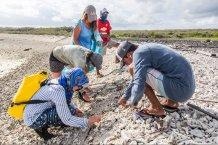May 31 2021
The Galapagos Islands were found to be polluted with plastic on beaches, in seawater, and within marine animals.

Plastic sampling on a beach in Galapagos. Image Credit Adam Porter.
A recent study, performed by the University of Exeter, Galapagos Conservation Trust (GCT), and the Galapagos Science Center, discovered that plastic was present in all aquatic habitats at the island of San Cristobal in which Charles Darwin initially landed in Galapagos.
In fact, over 400 plastic particles were detected for each square meter of beach at the worst “hotspots,” such as a beach utilized by the rare “Godzilla” marine iguana. Plastic was even detected inside more than 50% of the marine invertebrates (like urchins and barnacles) analyzed, as well as on the seabed.
These results indicate that a majority of plastic pollution in Galapagos—a renowned biodiversity haven in the world—reaches the ocean currents.
The new study also discovered that marine vertebrates, such as sea turtles, sea lions, whale sharks, and scalloped hammerheads, in Galapagos face the greatest risk from getting entangled or swallowing plastic.
The pristine image of Galapagos might give the impression that the islands are somehow protected from plastic pollution, but our study clearly shows that’s not the case. The highest levels of plastic we found were on east-facing beaches, which are exposed to pollution carried across the eastern Pacific on the Humboldt Current.
Dr Ceri Lewis, Global Systems Institute, University of Exeter
“These east-facing beaches include Punta Pitt, a highly polluted site that is home to Godzilla marine iguanas which—like so much Galapagos wildlife—are found nowhere else in the world, ” added Dr. Lewis.
There are less than 500 Godzilla marine iguanas in existence, and it’s concerning that they are living alongside this high level of plastic pollution.
Dr Ceri Lewis, Global Systems Institute, University of Exeter
Speaking about the tiny particles detected within marine invertebrates, the study lead author Dr. Jen Jones from GCT stated, “These animals are a crucial part of food webs that support the larger species that famously live on and around the Galapagos Islands. The potential health effects of plastic ingestion on marine animals are largely unknown, and more research is needed.”
The study results include:
- Only 2% of “macroplastic” (fragments and items bigger than 5 mm) was found to be emerging from the islands. While the actual figure may be higher, the results strongly indicate that a majority of plastic reaches the ocean currents.
- Such macroplastics were detected at 13 of 14 sandy beaches analyzed, and a total of 4,610 items was collected. Huge microplastics (measuring 1 to 5 mm in size) collected from the surface 50 mm of sand were identified at 11 of 15 tested sites.
- Low concentrations of microplastics were detected in all seawater and seabed samples, with more concentrations at the harbor indicating some local input.
- A considerable build-up of plastic was also detected in major habitats, such as mangroves and rocky lava shores.
- All the seven marine invertebrate species that were analyzed were observed to contain microplastics. Plastic was detected in 52% of the 123 individuals tested.
To examine the potential effect of plastic on Galapagos marine vertebrates, like turtles and sea lions, the team assessed a total of 138 studies of the ingestion and entanglement of plastics among these animals across the world.
The researchers also considered where every species in Galapagos is known to survive and factored in the conservation status of these species on the IUCN Red List of Threatened Species. On the basis of this outcome, the analysis identified 27 species that need to be urgently monitored and mitigated.
Dr. Jones, who headed the research work as part of her Ph.D. at the University of Exeter, added: “Our study highlights how far plastic pollution travels, and how it contaminates every part of marine ecosystems. Given the level of pollution, we have found in this remote location, it’s clear that plastic pollution needs to stop at the source. You can’t fix the problem just by cleaning beaches.”
This situation is only going to get worse if we don’t dramatically change our use of plastics.
Dr David Santillo, Greenpeace Research Laboratories, University of Exeter
In 2020, the researchers won a £3.3 million grant from the United Kingdom government to study and deal with plastic pollution in the Eastern Pacific. But the grant has been decreased by 64% and is likely to be annulled after the first year because of Official Development Assistance (ODA) cuts declared in March.
The Spotlight 400 imaging FT-IR microscope employed in this analysis was accessed thanks to a Research Partnership Agreement between PerkinElmer and the Greenpeace Research Laboratories. This latest study was financially supported by GCT and the Royal Geographical Society.
Journal Reference:
Jones, J. S., et al. (2021) Plastic contamination of a Galapagos Island (Ecuador) and the relative risks to native marine species. Science of the Total Environment. doi.org/10.1016/j.scitotenv.2021.147704.